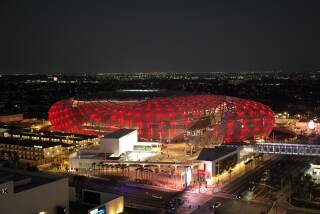OFF THE WALL : Indoor Climbing Face in Chatsworth as Good as a Piece of the Rock
Ed Bannister climbs the walls at work. Not that he’s bored stiff with his job. Bannister just happens to work at a place that encourages such behavior. And promotes it.
Bannister owns a store in Chatsworth called Art of Climbing, which sells everything a climber needs to be fashionable on the rock and not fall off. But what makes it unusual is the floor-to-ceiling climbing wall that stretches 72 feet around the interior of the shop. The plywood wall is to rock hounds what a jungle gym is to 6-year-olds.
“It’s great,” says Kuan Jin of North Hollywood, a sinewy 20-year-old climber with a wispy mustache. “You can work till your arms drop off.”
While not claiming to outdo El Capitan in terms of thrills, Bannister, 34, says that his wall--built three months ago--will get climbers ready for the real thing.
“The skills you learn on the indoor wall apply to climbing in Yosemite or places in the Sierra,” he says.
The fact that Bannister would open a playpen for rock hounds reflects what he says is an increasing interest in the sport. Bannister, who has worked in the field for 12 years, puts the number of serious recreational rock climbers in this country at 50,000, an increase of 50%, he says, in the past two or three years and 500% in a decade.
The specialized shoes help tell the story.
“Ten years ago, there was only one major brand--E.B. Climbing Shoes--and it sold about nine (thousand) to 10,000 pairs a year. I should know--I used to work for them,” Bannister says. “Now there are 15 major brands and 50,000 pairs a year are sold.”
Bannister, who grew up and still lives in Pasadena, has more than a little experience in the sport. “I had 800 climbs in the Sierra before I was 18,” he says. In the 1970s, according to Bannister, rock climbers came from the ranks of hard-core backpackers who wore plaid shirts and ate granola bars. But Bannister has noticed that the breed is changing. They’re “not exclusively yuppies,” he says, but . . .
“They’re less Euell Gibbons nut eaters and more athletes. I’m seeing rock climbers who’ve never carried a backpack or who think being out overnight means staying in a motel. We’re definitely getting a different personality than we’ve had in rock climbing. People are training for climbing now--they’re even building artificial walls in their garage--and we’ve never had that.”
And because climbers train, they need all the right stuff: Bannister sells 13 brands of rubberized climbing shoes, with prices ranging from $61 to $138; a $94 hang board that every climber should have nailed above his bedroom door; 11-millimeter Edelrid nylon rope; 20 styles of aluminum carabiners, chalk bags, workout clothes and framed Ansel Adams photos. Climbers apparently have the same taste as surfers: all their gear radiates in fluorescent orange, yellow, green and red colors.
“Fashion is more important than ever in rock climbing,” says Bannister, who wears glasses and a flattop. “Now your chalk bag has to coordinate with your harness.”
It’s no coincidence that Bannister chose Chatsworth as the location for his 1,300-square-foot specialty shop--which he says is the only one of its kind in California. He draws his clientele from the rock climbers at nearby Stoney Point, a popular boulder-strewn city park considered one of the world’s best training sites.
But the park is free and Bannister charges $100 a year for unlimited use of his wall. And why go indoors when the Point is less than a mile up Topanga Canyon Boulevard.
“ ‘Cause it gets dark,” Jin says. “Or it rains or gets too hot.”
Bannister built his wall with his climbing partner, Brett Maurer. The knobs and jugs--resin-and-sand holds bolted to the plywood--can be removed with an Allen wrench and moved to different locations on the wall. Most of the 150 holds on the wall have been imported from France, where climbing on artificial surfaces, Bannister says, is a popular spectator sport.
The French, considered the best rock climbers in the world, are favorites to win the gold medal at the 1992 Olympics, where rock climbing will be a demonstration sport. The French have an edge because Olympic-style rock climbing is held on vertical artificial walls, which abound in France, Bannister says. The United States has only one vertical wall, a 115-foot-high course in Snowbird, Utah.
“An artificial wall with moveable holds prevents local geographic advantages in competition,” Bannister says. “Familiarity is a huge advantage in rock climbing.”
On the vertical wall at Art of Climbing, Jin was spread-eagled, his feet and fingers glommed onto the holds, chalk smeared over his hands. Only allowed to use the holds marked by orange dots, he was attempting a traverse, following a route designed by experienced climbers and changed once a month by Bannister. After finishing, he jumped down and shook his arms.
“You go back and forth for 20 minutes,” he says, “and you get a major burning sensation in your forearms. But it’s still fun.”
More to Read
Sign up for The Wild
We’ll help you find the best places to hike, bike and run, as well as the perfect silent spots for meditation and yoga.
You may occasionally receive promotional content from the Los Angeles Times.






